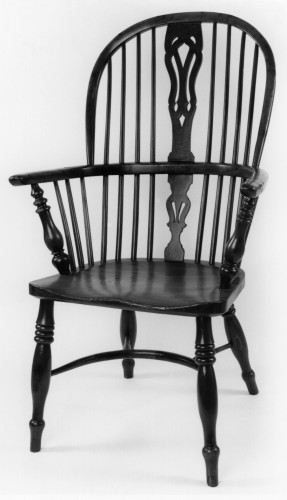279/2005
Collection
English Regional Chairs
Brief description
High back double bow Windsor armchair made from yew with an elm seat, back legs and stretcher supports. The chair is stamped F.WALKER.ROCKLEY on the right edge of the seat. This refers to Frederick Walker, a chair maker active between 1823 and 1871 in Rockley, Nottinghamshire.
Object name
chair
armchair
armchair
Object number
279/2005
Production person
Walker, Frederick (maker)
Production date
1823-1871
Production place
Rockley (made)
NE-N (ERC) (made)
NE-N (ERC) (made)
Physical description
Large high Windsor arm chair with pierced central splats
back bow tapers into arm bow; splat in 2 parts; underarm turning type UAT2 specific to Notts Windsors; upwardly tapered spindles; 2 small upper extra tear-shaped piercings denote that this is a 'best' chair made principally of yew.
Chair back: high back double bow; back bow tapers & mortices into arm bow & supports 4 tapered turned spindles either side of central pierced spalts
Splat type: central pierced splat in 2 parts; upper has gothic motif in lower piercing
Front legs: 3 ring turned legs with vase shaped feet; legs extended
Back legs: 3 ring turned legs with vase shaped feet; legs extended
Feet: vase shaped feet
Stretcher detail: curved 'crinoline' stretcher connected to back legs by 2 turned back supports
Front stretcher: -
Back stretcher: -
Arm: bent arm bow with chamfered ends
Underarm supports: decoratively turned underarm support type UAT2 specific to Notts Windsors & 3 upwardly tapered turned short spindles
Seat: legs morticed into seat
back bow tapers into arm bow; splat in 2 parts; underarm turning type UAT2 specific to Notts Windsors; upwardly tapered spindles; 2 small upper extra tear-shaped piercings denote that this is a 'best' chair made principally of yew.
Chair back: high back double bow; back bow tapers & mortices into arm bow & supports 4 tapered turned spindles either side of central pierced spalts
Splat type: central pierced splat in 2 parts; upper has gothic motif in lower piercing
Front legs: 3 ring turned legs with vase shaped feet; legs extended
Back legs: 3 ring turned legs with vase shaped feet; legs extended
Feet: vase shaped feet
Stretcher detail: curved 'crinoline' stretcher connected to back legs by 2 turned back supports
Front stretcher: -
Back stretcher: -
Arm: bent arm bow with chamfered ends
Underarm supports: decoratively turned underarm support type UAT2 specific to Notts Windsors & 3 upwardly tapered turned short spindles
Seat: legs morticed into seat
Dimensions
Height: 110.2mm
Width: 65.2mm
Depth: 67.8mm
Width: 65.2mm
Depth: 67.8mm
Label
Label text for the exhibition The English Regional Chair, Geffrye Museum (15 February 2005–7 June 2005):
Windsor armchair, high back double bow
Yew with elm seat, back legs and stretcher supports, stamped F.WALKER.ROCKLEY on right edge of seat. Refers to Frederick Walker, fl.1823–71, Rockley, Nottinghamshire.
A small but significant community of Windsor chairmakers was founded in the hamlet of Rockley, Nottinghamshire by William Wheatland in the 1820s. Wheatland was a Methodist preacher as well as a chairmaker. By 1841 he was joined by four other makers, including Frederick Walker, who was to become the most productive and succeeded Wheatland as preacher. This chair is of yew, with a curved stretcher known as a ‘crinoline’, named after the hooped petticoats worn by women at the time. The chair is typical of the high quality evident in the Rockley tradition.
Cotton Collection (ne-n5).
North East (Nottinghamshire).
Windsor armchair, high back double bow
Yew with elm seat, back legs and stretcher supports, stamped F.WALKER.ROCKLEY on right edge of seat. Refers to Frederick Walker, fl.1823–71, Rockley, Nottinghamshire.
A small but significant community of Windsor chairmakers was founded in the hamlet of Rockley, Nottinghamshire by William Wheatland in the 1820s. Wheatland was a Methodist preacher as well as a chairmaker. By 1841 he was joined by four other makers, including Frederick Walker, who was to become the most productive and succeeded Wheatland as preacher. This chair is of yew, with a curved stretcher known as a ‘crinoline’, named after the hooped petticoats worn by women at the time. The chair is typical of the high quality evident in the Rockley tradition.
Cotton Collection (ne-n5).
North East (Nottinghamshire).
Rights note
copyright of photo: B D Cotton




